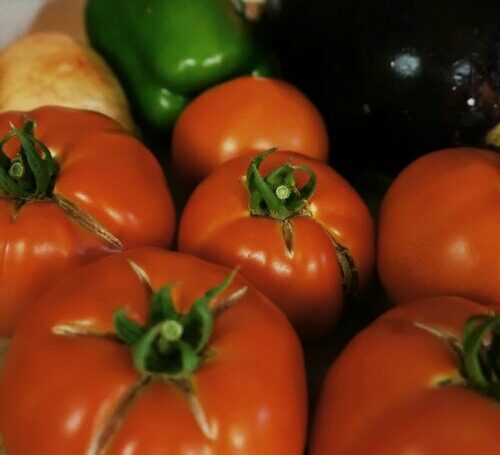
Not-Your-Corner-Italian-Eatery Eggplant Parmesan
At the height of growing season, when the calendar is flipping from July to August, a deluge of vegetables starts overwhelming me. Despite a near total loss of squash to bugs, the garden is bursting from its beds. Collards, kale, garlic, tomatoes, cucumbers, lettuce, beans, herbs are all crops selected to complement the onslaught of CSA vegetables coming on a weekly basis whether I like it or not. This onslaught brings in bags of eggplants, onions, potatoes, leeks, squash, beets, carrots corn, and more garlic, tomatoes, greens, lettuce and herbs. Finally, my impulsive visits to the farmers markets bring additional goodies, like more garlic and tomatoes that I just can’t live without.
As this stuff comes pouring in, I go into full battle mode dispatching of as much of it as quickly as possible. Every meal is loaded with vegetables. Out of necessity and in the interest of my very limited ability to divvy up mental space to complex matrices of vegetable preparation techniques (systems of partial differential equations was not my strong suit in engineering school), this intense vegetable activity requires simple recipes. Grilled squash. Blanched corn. Sliced tomatoes. Sautéed greens. Juiced beets and cukes. Garnishes of basil, mint, oregano. Diced onions. Smoked peppers. Oh, and, we should have a side salad with that too. What we can’t consume gets preserved. Frozen cobs. Zucchini loafs in the deep freeze. Pickled cukes. Beet relish. Fermented cabbage. Dilled beans.
And then there is my Not-Your-Corner-Italian-Eatery Eggplant Parmesan.
It does not involve breading the eggplants. There is no time for breading. Forget about frying eggplant in oil. There is no reserve energy to fry them in oil. Non-breaded and non-fried eggplants are not smothered in sauce. Making sauce is not an option unless I can dip into something on its way to water bath canning. The Corner-Italian-Eatery Eggplant Parmesan asks too much time, has too many steps and requires too much mental capacity for me to bother making it. Even when I am overloaded with eggplants, I cannot muster the momentum to do all that work and thinking. Besides, it really isn’t that good, is it? Work and thinking are exactly why most people do not get their Eggplant Parmesan homemade from their oven They buy it from the Corner-Italian-Eatery because dialing up requires little of work or thought even if the taste is marginal. Mystery solved.
But, alas, what is one to do with an abundance of classic eggplants? To clarify, the long, slender, deep-purple and mildly bitter Japanese or the similar, but light purple and white yet slightly sweeter Chinese eggplants quickly get grilled, sauteed or stir fried. The petite, little, tear-drop shaped and delicately sweet fairy tale eggplants can be halved, tossed on a hot cast iron pan and seared to perfection in moments. Any variety can be marinaded for days or weeks in olive oils and vinegars with basil and peppers. It is the large, purple orbs of the classic European and American varieties that beg to be in an Eggplant Parmesan.
The origins of the Corner-Italian-Eatery Eggplant Parmesan style we have all become familiar with are a bit muddy. There is pretty broad agreement that the stuff you get at many corner Italian eateries – limp eggplant with oil-saturated breading lost under a bland red sauce – is not what tradition intended. There tends to be a split on whether the name originated from the cheese, Parmigiano, or the city, Parma, or the bastardization of the Sicilian word palmigiana meaning ‘shutters’. The latter might refer to the style of construction of the dish. There are divisions over how to properly cheese Eggplant Parmesan – only Parmigiano, some Parmigiano or none, at all. Additionally, it seems fuzzy which version of eggplant preparation makes up a more or less traditional Eggplant Parmesan – breaded and fried, or floured and fried, or egged and fried, or naked and fried, or naked and grilled, or any aforementioned combination and baked. The combinations are endless. With that in mind, I feel content calling what I do with the large classic eggplants an ‘Eggplant Parmesan’ dish. Knowing that, I shall sleep better at night. Ahhh. . . zen.
Most of the effort of my Eggplant Parmesan goes into slicing. I layer salted-eggplant, tomatoes, onions, green peppers, garlic or garlic scapes, fresh herbs, fresh Olivine Mozzarella, Parmigiano-Reggiano, and olive oil directly into a pan. All uncooked. All as fresh as possible. Then, they get baked.
I soak the sliced eggplant in salted water. This is supposed to remove the ‘poisonous’ bitters from this nightshade fruit, but my reason to soak them is to get salt in. For tomatoes, I prefer very big, very ripe, very juicy beefsteak tomatoes. Fresh from the backyard is perfect. Typically, fresh slicing onions provide juicy sweetness and fresh bite. These too are arriving with eggplants from the CSA this time of year. Also in abundance are green peppers. These add crunch and a bit of bright green flavor and color. Garlic or garlic scapes (scapes are the green shoot from a hard-neck garlic plant) add a punch that says ‘Italian!’ The scape gives a more subtle proclamation than the fresh garlic. I use only fresh herbs in as much quantity as my plants can handle me harvesting at once. I also chose to use both fresh Olivine Mozzarella for its soft, melted, milky sweetness, and Parmigiano-Reggiano for its contrasting, sharp nutty, earthiness. Olive oil ties it all together and a high quality extra virgin provides a note of green olive.
Once built, all you do is bake them. They are hard to burn even if you crank the heat up or run a few errands while they bake.
The nice thing about making Eggplant Parmesan without the breading, frying and saucing is that it holds up well in cold storage. You can stick these pans in the it in the fridge for days either before or after baking. I prefer before because I can dig into these things cold. Want a killer breakfast? Top lightly warmed leftovers with a fried egg. I will freeze baked portions (be sure to drain the water) for a ready-to-go lunch.
I know not everyone has fresh herbs on hand or a garden and CSA. This recipe is pretty forgiving to variations. Tomato sauce can be added to the layers or substituted for fresh tomatoes. In the absence of fresh onions, fresh garlic or scapes, aged bulbs or even dried in a pinch will do. Dried herbs can also be used, but since the herbs are not married into the dish as they would be with a sauce, the overall mouth feel and fullness of flavor will be missing. You can even use some combination of shredded cheeses, but a package of shredded mozzarella will not impart the sweetness or the smooth, rich mouth feel a fresh mozzarella will.
Not-Your-Corner-Italian-Eatery Eggplant Parmesan
1 classic eggplant
Course Kosher salt for soaking (1/2 to 1 T per 1 Cup soaking water, depending on your preference)
3 large beefsteak tomatoes (even more is better)
2 large green peppers
2 small fresh slicing onions
3-4 cloves if garlic or 2-3 garlic scapes
1 bunch fresh basil
5-6 stems fresh oregano
8 oz fresh Olivine Mozzarella (adjust to preference)
3 oz finely shredded Parmigiano-Reggiano (adjust to preference)
Olive oil to taste (Extra Virgin for best results)
Course Kosher Salt
Fresh ground pepper
1. Soaking (1- hour ahead of baking)
Well ahead of time, slice an eggplant into large, round, 3/8-inch thick disks and soak them for at least an hour in salt water. Be sure to weigh them down so they remain fully submerged and do not brown. As an alternative, you can also generously sprinkle salt on them dry to draw moisture out, just be sure to rinse them before construction.
2. Slicing (20- minutes ahead of baking)
Preheat the oven to 400F.
Slice cored tomatoes to 1/4- inch thickness. Slice onions into super thin half-moons and green peppers into1/4-Inch thick ring. Thinly slice fresh garlic or finely chop garlic scapes. Chiffonad fresh basil and chop up fresh oregano. Slice fresh Olivine Mozzarella into rounds as thin as possible (no more than 1/4-inch). Finely shred the Parmigiano-Reggiano – I use a micro-plane.
3. Construction (10- minutes ahead of baking)
Lightly coat a baking dish with olive oil. I used two 14-inch by 6-inch oval dishes here.
Now, construction begins. Reserve a couple mozzarella slices and some herbs for sprinkling on top . Drain the and dry the eggplants on a towel and start layering. I like a firm foundation, so I start with a overlapping layer of eggplant on bottom with a layer of tomatoes. Sparsely layer onions, green peppers and garlic then lay in slices of mozzarella. My preference is to not densely pack or overlap the mozzarella because I aim for a dish that is mostly vegetable rather than a hot mess if cheese. Sprinkle in some herbs, salt and pepper and add a light drizzle of olive oil. Repeat the layering until everything but the Parmigiano-Reggiano and reserved herbs and mozzarella are used up.
Top each dish with reserved mozzarella and Parmigiano-Reggiano. Finish with a sprinkle of salt and pepper and a light drizzle if olive oil.
4. Baking
Cover each dish lightly with foil being careful not to press it into the cheese. Bake covered in the center of the oven at 400F for 30-45-minutes. Check if eggplant is tender and adjust time to get desired tenderness. There us likely a good amount of liquid that has come from the vegetables at this point. Additional uncovered baking and resting will reduce this. After desired tenderness ius reached, uncover and bake an additional 10-15 minutes until cheese is brown and bubbly.
5. Resting
Remove from the oven and top off with reserved herbs. Allow the Eggplant Parmesans to rest uncovered for 10 or more minutes before eating.
6. Enjoy!
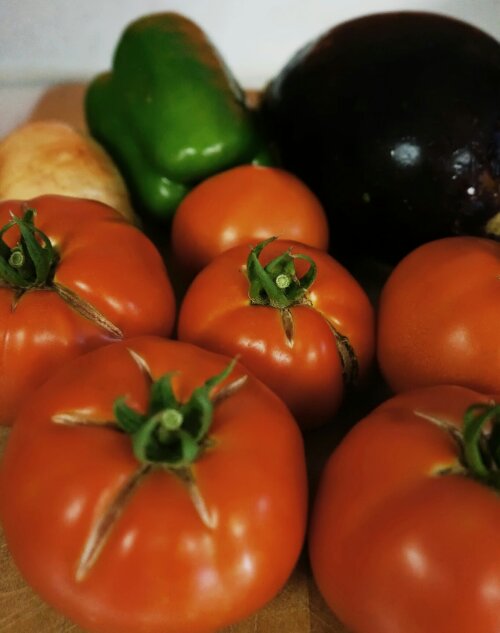
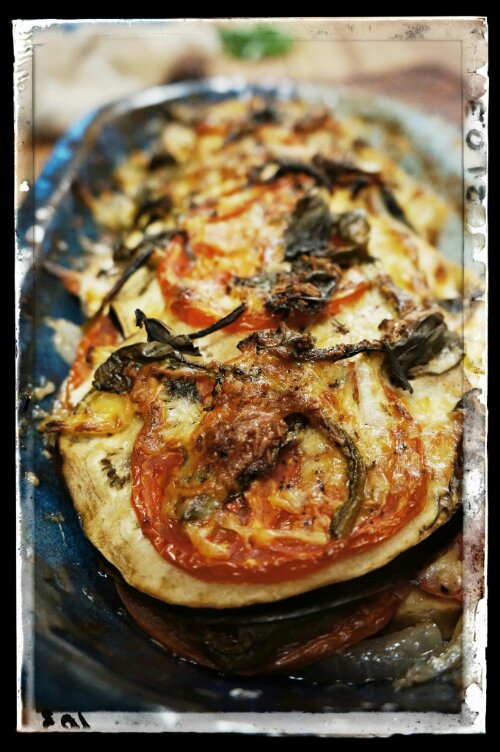
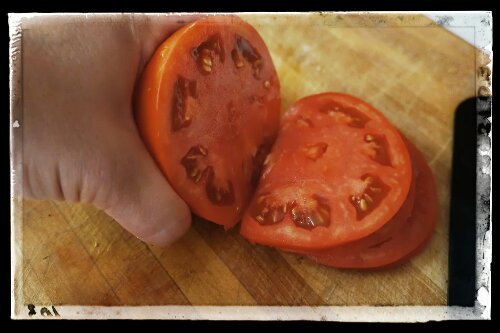
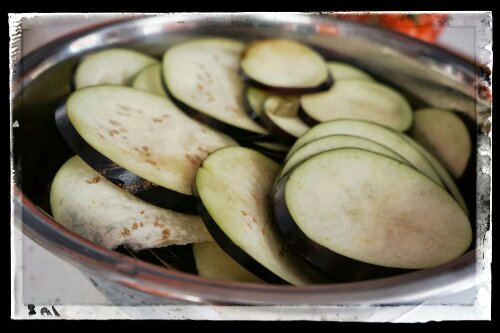
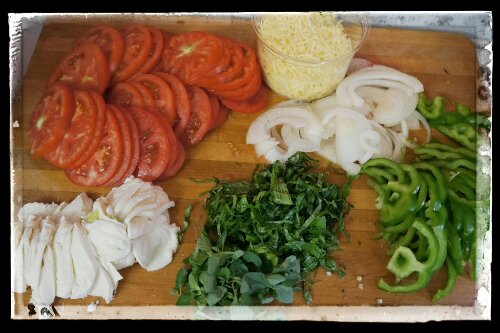




One Comment
[…] I love tomatoes in all forms – slices with a little salt and pepper, wedges in salads, in my Not-Your-Corner-Itilian-Eatery-Eggplant-Parmesan, in soups, in sauces, eaten like an apple, etc. But, there is nothing like a nice, homemade […]